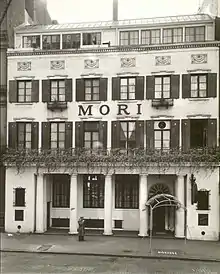Mori (restaurant)
Mori (1883 – 1937) was a Greenwich Village eating establishment that featured Italian cooking. It became bankrupt during the aftermath of the Great Depression. Its building later housed the Bleecker Street Cinema.
 Mori's Restaurant (1935) | |
| Address | 144 Bleecker Street, New York City, New York |
|---|---|
| Owner | Placido Mori |
| Type | restaurant, art house movie theatre |
| Construction | |
| Built | 1832 |
| Opened | 1883 |
| Renovated | 1883 |
| Closed | 1937 |
| Architect | Raymond Hood |
History
The building at 144-146 Bleecker Street in New York City's Greenwich Village was originally built in 1832 as two rowhouses.[1] Placido Mori[2] converted 144 into the restaurant Mori in 1883[1] or 1884. As architecture historian Christopher Gray wrote,
At some point, Mori befriended a novice architect, Raymond Hood, gave him a house tab and an apartment upstairs and in 1920 had him design a new facade for the building to include 146 Bleecker. Hood gave the buildings a row of Doric columns across the first floor, imitation Federal lintels over the windows and a setback penthouse studio.[1]
The restaurant began as a small bar and eatery and expanded to fully occupy a "rambling, old-fashioned" five-story[3] building near Sixth Avenue (Manhattan).[2] It survived the Prohibition era and the worst years of the Great Depression, when it was temporarily padlocked.
Mori closed in 1937,[1] and Placido Mori filed a petition for bankruptcy in early January 1938, stating that the corporation had no assets and liabilities totaling $70,000.[2] The building formerly occupied by Mori was sold by Caroline Bussing through A.Q. Orza, broker, in October 1943.[3]
Mori's gravesite in Woodlawn Cemetery in the Bronx is marked with a sculpted memorial designed by Hood and sculptor Charles Keck.
References
- Gray, Christopher (November 4, 1990). "Streetscapes: The Bleecker Street Cinema; The 'Lost' Frescoes of an Artist-Soldier". The New York Times. Retrieved April 7, 2013.
- "Mori's in Village Is Forced To Close". The New York Times. January 5, 1938. p. 23.
- Harlem Building Gets New Owner, New York Times, October 12, 1943, pg. 40.
